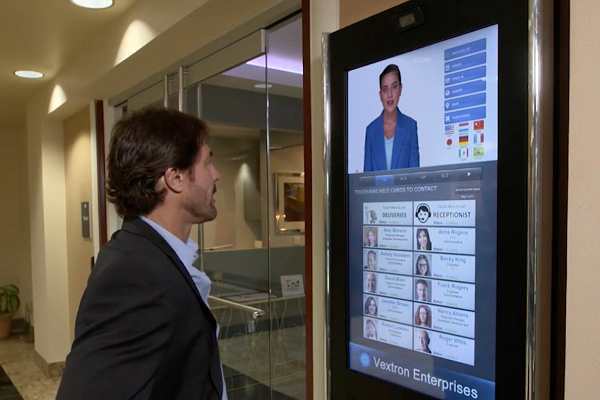Hour One’s Virtual Human Receptionist Alice Adds Multilingual Capability
 Virtual human software developer Hour One has taught its Alice Receptionist AI to speak in multiple languages. The virtual receptionist is capable of synthesizing speech and video simultaneously, regardless of the language or text it is given. This is a feature that, “augments what human subjects can do in real life,” said Natalie Monbiot of Hour One in an interview with Voicebot. “You can submit new text in Spanish, Arabic, German, etc. without having to back to the studio. We are replacing the camera with code.”
Virtual human software developer Hour One has taught its Alice Receptionist AI to speak in multiple languages. The virtual receptionist is capable of synthesizing speech and video simultaneously, regardless of the language or text it is given. This is a feature that, “augments what human subjects can do in real life,” said Natalie Monbiot of Hour One in an interview with Voicebot. “You can submit new text in Spanish, Arabic, German, etc. without having to back to the studio. We are replacing the camera with code.”
The AI can welcome and check-in guests, print badges and connect people with human employees for video chats. Those capabilities now include conversing in more than just English. Hour One has taught the Alice AI Spanish, Arabic, and French Canadian, and has plans to install more soon.
Multi-Lingual Alice
Alice performs the same role as a receptionist in office buildings, hotels, and conference venues, except the visual and vocal elements, are synthesized digitally to create the impression of a human speaking the words the person interacting with it hears. This approach offers versatility for a virtual human receptionist.
The software takes images of a real human and renders a virtual human on screens in humanlike form with natural motions, including speaking. To change the content of what the virtual human says, users only need to change the text input. The text-to-speech (TTS) engine can then speak the new content and the visual rendering dynamically adjusts the video image to make the spoken words seem naturally delivered by the video image. This works within a single language and the new features enable a similar capability accommodating new languages.
Hour One claims that generating new speech that matches the AI’s mouth movements only takes a few minutes. That reduction in time and cost is part of the sales pitch for Alice and HourOne’s other AI assistants. There’s no concern about missteps in video continuity when the entire thing is produced from the ether without any real-world complications. Including extra languages doesn’t cause issues with dubbing or jarring visual effects the way it might if the receptionist were a video of a human speaking answers to common question captured in the studio.
Instead, users type out the text and pick the AI and language they want to speak it, and can get multiple options for the final video depending on what they think goes best with their project. The text can be edited whenever necessary so the receptionist doesn’t give information that is obsolete.
“Making content the traditional way is a long and costly process, not to mention the severe limitations to revising content needed for agile communications,” said Natalie Monbiot in a statement. “With Hour One’s end-to-end video creation platform, we are happy we can help ALICE solve for this, and enable greater scalability while maintaining an elevated customer experience, supporting market expansion.”
Virtual Human Evolution
The demand for virtual humans is rising steadily as the technology improves and becomes useful in more verticals. The receptionists powered by Hour One are in the same family as the videos created by Synthesia a startup that recently raised $12.5 million to continue developing its platform for producing videos for the marketing and educational markets. As visual tools like MetaHuman Creator and synthetic voice platforms like Replica Studios continue to arrive, movies and video games are going to be populated with virtual creations performing according to a script without anyone walking into a studio. Interactive virtual humans like Alice are part of the next generation, along with the virtual influencers built by CoCo Hub, the digital Einstein who can talk about his life, Virti’s doctor-training virtual humans, and even the Nestle Toll House “cookie coach” Ruth.
It is worth noting that ALICE is not a chatbot. Unlike virtual humans such as Kuki and Sophia, ALICE is completely driven by scripted content. “In all kinds of automation if you can add a level of humanity that adds value,” says Monbiot. She continued by saying that the scripted video approach also provides control and brand protection for companies along with the added “humanity.”
Companies using ALICE or Hour One’s other solutions don’t have to worry about the virtual human saying something unexpected. It will only respond to human users with scripted responses. That may limit the scope of what these virtual humans can do but that is the point. They are designed to consistently perform a narrow function. Now that function can also be performed in multiple languages.
Follow @voicebotaiFollow @erichschwartz
Virti’s Virtual Patients Are Training Doctors to Communicate
‘Digital Einstein’ Virtual Human Celebrates Nobel Prize Centennial








